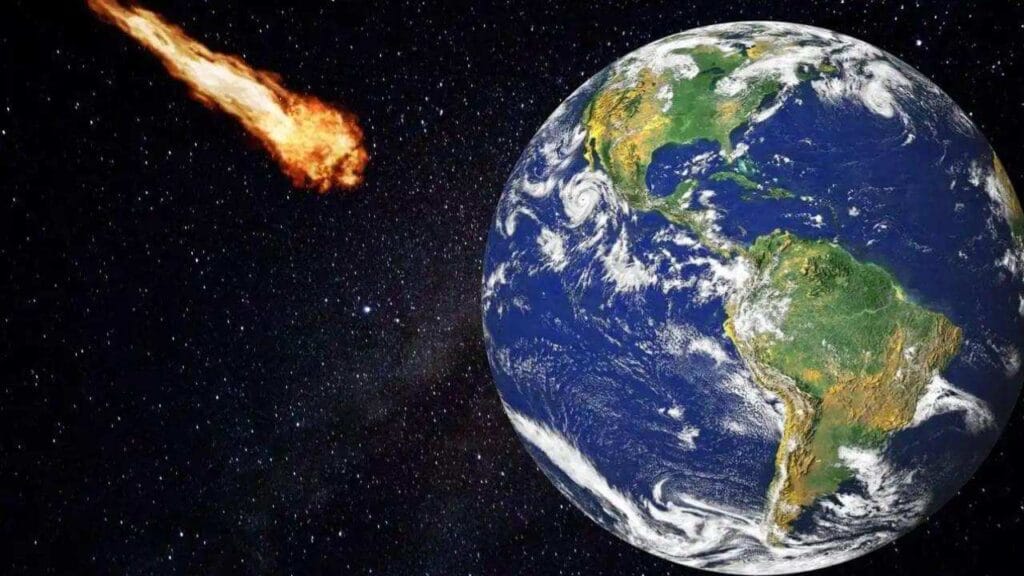Asteroid 2003 MH4, an Eiffel Tower-sized rock from space, recently zoomed past Earth on May 24, 2025, at a mind-blowing speed of 50,400 km/h (about 31,300 mph). While it didn’t crash into us (thankfully), it did get close enough to raise eyebrows at NASA and among sky-watchers around the world.

This near-Earth object (NEO), also known by its formal designation 387746 (2003 MH4), came within about 6.68 million kilometers (4.15 million miles) of our planet—roughly 17 times the distance between Earth and the Moon. That’s pretty close in astronomical terms, and while there was no danger of impact this time, scientists are keeping an eye on it.
Asteroid 2003 MH4
| Aspect | Details |
|---|---|
| Asteroid Name | 2003 MH4 (Official: 387746) |
| Size | Approx. 335 meters (Eiffel Tower-sized) |
| Speed | 50,400 km/h (31,300 mph) |
| Closest Approach Date | May 24, 2025 |
| Distance from Earth | 6.68 million kilometers (17 lunar distances) |
| Threat Level | No threat this pass; classified as Potentially Hazardous Asteroid (PHA) |
| Monitoring Agency | NASA Center for Near-Earth Object Studies (CNEOS) |
Asteroid 2003 MH4’s close flyby on May 24, 2025, is a wake-up call and a win at the same time. It passed safely, as expected—but reminded us that space is full of surprises. With the right technology, teamwork, and heads-up awareness, we’ve got a good shot at protecting Earth from any future cosmic curveballs. Keep looking up—but maybe keep one eye on those asteroid trackers, too.
So, What Is Asteroid 2003 MH4?
Discovered in 2003, this hunk of space rock has a nearly one-year orbit around the Sun. It belongs to the Apollo group of asteroids, which are known for crossing Earth’s orbit. What makes 2003 MH4 especially interesting is its size—over 1,000 feet wide—and its “potentially hazardous” label, meaning it gets close enough and is big enough to be taken seriously.
But don’t panic! “Potentially hazardous” doesn’t mean it’s coming to wipe us out. It just means NASA and other space agencies are keeping tabs on it.
Why Do Scientists Care So Much About This Space Rock?
1. It’s Big Enough to Cause Trouble
If an asteroid this size did hit Earth, it could release energy equivalent to hundreds of nuclear bombs. According to NASA, a 300+ meter asteroid could cause regional devastation, tsunamis (if it hits water), or worse.
2. It Helps Us Test Planetary Defense
Even though 2003 MH4 didn’t hit us, flybys give scientists a chance to track its path, study its composition, and practice using tech like DART (Double Asteroid Redirection Test) in case we ever do need to deflect one.
3. It Teaches Us About the Solar System
These asteroids are leftovers from the early solar system, meaning they’re like time capsules. Studying them helps us understand how Earth and its neighbors formed.
How Close Did It Really Get?
To put it in perspective:
- The Moon is about 384,000 km (239,000 miles) away from Earth.
- 2003 MH4 passed at a distance of 6.68 million km (4.15 million miles).
That’s far enough to be safe but close enough for telescopes to pick up. NASA’s Sentry Risk Table, which monitors close approaches, had 2003 MH4 on the radar, but with zero risk of impact.
“Think of it as a cosmic drive-by. Nothing dangerous, just a reminder that the solar system is still a wild place,” said NASA planetary defense officer Lindley Johnson.
What Would Happen if 2003 MH4 Hit Earth?
Let’s play “what if.”
- A 335-meter object crashing into Earth could release over 1,200 megatons of TNT energy.
- That’s roughly 60 times more powerful than the largest nuclear bomb ever detonated (Tsar Bomba).
- An impact could level a city, trigger fires, and cause massive atmospheric dust clouds.
Thankfully, NASA’s impact monitoring software (like Sentry II) calculates that there’s no impact expected in the foreseeable future.
How NASA and the World Are Preparing
The good news? We’re not sitting ducks. Agencies around the globe are investing in planetary defense strategies:
1. DART Mission
NASA’s DART mission, launched in 2021, tested deflecting an asteroid by crashing a spacecraft into it. It was a huge success and proved we can change an asteroid’s trajectory.
2. NEO Surveyor
Scheduled to launch in 2027, the Near-Earth Object (NEO) Surveyor is a space telescope designed to spot smaller and harder-to-see asteroids.
3. Global Collaborations
NASA works with ESA (European Space Agency), JAXA (Japan), and others to track and study thousands of NEOs. You can even follow along at NASA’s NEO Tracker.
What Can You Do? (Yes, You!)
1. Stay Informed
Bookmark sites like nasa.gov and spaceweather.com to stay updated on close approaches.
2. Get Involved
Want to help track space rocks? Check out NASA’s Planetary Defense Citizen Science Projects, where you can help classify images and spot asteroids.
3. Support Science Funding
Planetary defense isn’t sci-fi—it’s real. Supporting funding for NASA, NOAA, and science education helps ensure we’re ready for future encounters.
FAQs On Asteroid 2003 MH4
Q: Was Earth in danger from Asteroid 2003 MH4?
A: No. It passed safely at a distance of over 6 million km—17 times farther than the Moon.
Q: Is it coming back?
A: Yes, but not any time soon. Its orbit is tracked closely, and it won’t pose a threat for at least the next 100 years.
Q: How big does an asteroid need to be to threaten Earth?
A: Anything over 140 meters is considered “potentially hazardous.” 2003 MH4 is 335 meters, so it’s on the larger side.
Q: Could we stop it if it was on a collision course?
A: Possibly. Missions like DART have shown we can alter an asteroid’s course, especially if we detect it early enough.
Q: Can I see it with a telescope?
A: You’d need a decent backyard telescope and a dark sky. It was visible for a few days around May 24, 2025.












